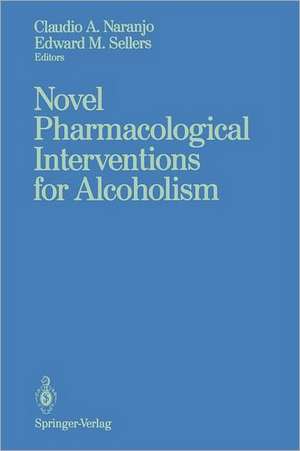Novel Pharmacological Interventions for Alcoholism
Editat de Claudio A. Naranjo, Edward M. Sellersen Limba Engleză Paperback – 25 sep 2011
Preț: 374.41 lei
Preț vechi: 394.12 lei
-5% Nou
Puncte Express: 562
Preț estimativ în valută:
71.65€ • 76.61$ • 59.73£
71.65€ • 76.61$ • 59.73£
Carte tipărită la comandă
Livrare economică 17 aprilie-01 mai
Preluare comenzi: 021 569.72.76
Specificații
ISBN-13: 9781461277057
ISBN-10: 1461277051
Pagini: 400
Ilustrații: XV, 378 p.
Dimensiuni: 155 x 235 x 21 mm
Greutate: 0.56 kg
Ediția:Softcover reprint of the original 1st ed. 1992
Editura: Springer
Colecția Springer
Locul publicării:New York, NY, United States
ISBN-10: 1461277051
Pagini: 400
Ilustrații: XV, 378 p.
Dimensiuni: 155 x 235 x 21 mm
Greutate: 0.56 kg
Ediția:Softcover reprint of the original 1st ed. 1992
Editura: Springer
Colecția Springer
Locul publicării:New York, NY, United States
Public țintă
ResearchDescriere
Novel Pharmacological Interventions for Alcoholism identifies priorities for focusing alcoholism and addiction research efforts during the coming years. A number of important issues concerning methodology, mechanisms, clinical evaluation, and pharmaceutical aspects are discussed. This book is also a plea for a greater degree of collaboration among academics, pharmaceutical physicians and scientists, and drug regulators; it demonstrates that progress in understanding and fighting addiction and alcoholism is possible in the foreseeable future.
Cuprins
I. General Methodologic Issues.- 1. Animal Models for Testing Drug Effects on Alcohol Consumption.- 2. Animal Models for Screening Drugs to Decrease Alcohol Consumption.- 3. Medications for Alcohol Abuse and Dependence: Methodology for Clinical Studies.- 4. Some Issues in the Evaluation of a Pharmacotherapy of Alcoholism.- II. Serotonin and Alcohol Consumption.- 5. Serotonin and Alcohol Consumption.- 6. Serotonergic and Dopaminergic Involvement in Ethanol Intake.- 7. Serotonin and Alcohol Consumption.- 8. Basic and Clinical Studies on Serotonin, Alcohol, and Alcoholism.- 9. Evaluation of the Effects of Serotonin Uptake Inhibitors in Alcoholics: A Review.- III. Opioids and Alcohol Consumption.- 10. Opioids Modulate Rats’ Propensities to Take Alcoholic Beverages.- 11. The Enkephalinergic System and Maintenance of Ethanol Drinking.- 12. The Relationship of Alcohol Drinking and Endogenous Opioids: The Opioid Compensation Hypothesis.- 13. Naltrexone in the Treatment of Alcohol Dependence: Preliminary Findings.- IV. The Role of Other Neurotransmitters in Regulating Alcohol Intake.- 14. Neurotransmitter Systems Regulating Alcohol Intake.- 15. Agents Which Modify Channels as Potential Treatments in Alcohol Withdrawal.- 16. Management of Alcohol Consumption with Angiotensin Converting Enzyme Inhibitors: A Review of the Animal Findings.- 17. Enalapril Does not Decrease Alcohol Intake in Normotensive Alcoholics.- Poster Papers.- General Methodologic Issues.- Rational vs. Reflexive Alcohol Drinking.- Rats’ Intakes of Different Alcoholic Beverages.- Drug-induced Specific and Nonspecific Changes in Voluntary Ethanol Intake by Rats.- Rationale for Alcoholism Treatment Based on Inhibition of Aldehyde Dehydrogenase.- The Effect of Low Alcohol Beverages on Alcoholism Levels in Canada in 1986.- Alcoholism, Antisocial Behavior, and Family History: A Synopisis.- Perception of Whether Drug or Placebo has been Administered is a Determinant of Drinking Reduction.- Disulfiram Treatment of Alcoholism.- Controlled Release Disulfiram (DS) Implant.- Depot Disulfiram: Pharmacokinetics and Clinical Effects During 28 Days Following a Single Subcutaneous Dose.- Mildly Intoxicating Levels of Alcohol Produces Direct Myocardial Depression on Left Ventricular Performance.- A Human Model for Testing Drug-induced Concomitant Variations in Alcohol Consumption and Desire to Drink.- Serotonin and Alcohol Consumption.- Mianserin, a Serotonergic Antagonist, and Intake of an Alcoholic Beverage.- Effects of the 5-HT Uptake Inhibitor, Sertraline, on Ethanol, Water and Food Consumption.- Fluvoxamine is Poorly Tolerated by Alcoholics.- Opioids and Alcohol Consumption.- Effects of Differential Handling on Rats’ Intake of Alcohol.- Stereoselectivity of Opioids’ Effects on Intake of an Alcoholic Beverage.- Metabolites of Morphine and Intake of an Alcoholic Beverage.- Peripheral Administrations of TIQS and Intake of an Alcoholic Beverage.- Morphine Enhances Intake of an Alcoholic Beverage Regardless of Type of Flavoring.- LY78335, an Inhibitor of Phenylethanolamine N-methyltransferase, and Rats’ Intake of an Alcoholic Beverage.- LY255582, an Opioid Antagonist, and Intake of an Alcoholic Beverage.- Effects of Naltrexone on the Cognitive Functioning of Recently Abstinent Alcohol Dependent Patients.- The Role of Other Neurotransmitters in Regulating Alcohol Intake.- Calcium-diacetyl-homotaurinate which Prevents Relapse in Weaned Alcoholics Decreases the Action of Excitatory Amino Acids in Neocortical Neurons of the Rat in Vitro.- THC, an Active Ingredient in Marijuana, and Rats’ Intake of a Sweetened Alcoholic Beverage.- Cocaine and Rats’ Intake of an Alcoholic Beverage.- Calcium-acetylhomotaurinate for Maintaining Abstinence in Weaned Alcoholic Patients: A Placebo-controlled Double-blind Multicenter Study.- Effects of Angiotensin Converting Enzyme Inhibitors on Free Choice Ethanol Consumption by Rats.- Calcium Channel Antagonists Attenuate the Alcohol Dependence Syndrome.- Pharmacological Antagonism of Ethanol by Dl-?-tocopherol.- Characterization of DSM-IIIr Criteria for Uncomplicated Alcohol Withdrawal: Proposal for a Diagnostic Inventory and Revised Withdrawal Scale.- Ethanol Effects of CNS Dopamine Receptors: In vivo Binding Following Voluntary Ethanol (ETOH) Intake in Rats.- Closing Remarks.- Author Index.











